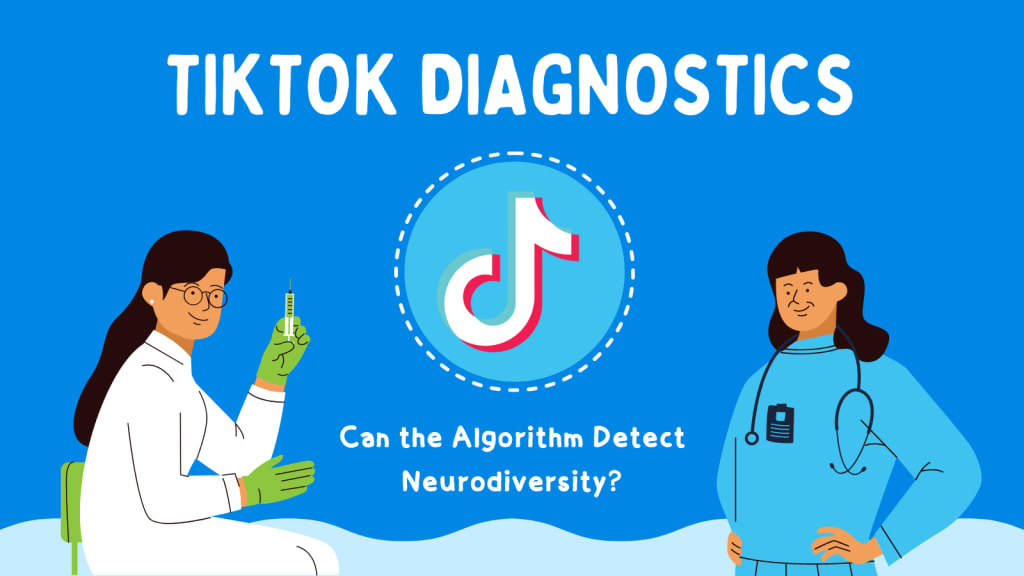TikTok Keeps Diagnosing People with Neurodiversity. Is it Valid?
On Algorithm Diagnostics - ADHD, Autism, OCD, and TikTok Psychiatry

It started out as a single, short video. An influencer remarked on his ability to hyperfocus on tasks that he was interested in. I watched the whole thing, nose-exhaled, tapped the heart, and went about my doom scroll. Suddenly, my FYP was filled with ADHD-related content. Worse yet, the content toted relatable ADHD symptoms - I couldn’t help but wonder, should I have been diagnosed with this disorder?
This phenomenon has become increasingly common on TikTok. People find themselves on the “neurodivergent side of TikTok” and believe that the algorithm is picking up on some part of their subconscious part of their mind.
This TikTok diagnosis has led to an uptick in actual medical ADHD diagnoses by trained health professionals, and an increased demand of adderall so great that the FDA has noted that it has exacerbated the Adderall shortage crisis.
But, is TikTok harming the populace with misdiagnosis? Or is it simply giving people a better understanding of their own minds - and pointing out a need for better understanding of neurodiversity? I sought out to find the answer.
How The TikTok Algorithm Works
TikTok’s algorithm may seem rather sophisticated, but the logic behind the content that you see is surprisingly simplistic. The content that you see is based on just three basic sets of information: your device and account settings, the content attached to videos, and the way that you interact with the platform.
Interactions: How You Interface with TikTok
The interactions you perform on TikTok can be divided into four types: commenting, following, liking, and watching. Though the weight of each of these interactions aren’t publicly available, they each contribute to what content will be shown to you next.
Video Content: The Information Creators Provide
TikTok is designed to specifically give you more of what you like. So, when you interface with a video by liking, commenting, following, or rewatching, the app uses the data from that video to send you similar videos afterwards. Again the weight of each aspect of this process isn’t publicly available, but the data it uses includes:
- Sounds - The music that’s present in the background of a video
- Captions & Descriptions - The text and keywords used in the video’s description section
- Hashtags - The tags that the creator deem relevant to the video
- Text Overlays - The text that creators add on top of their videos, including captions
Settings: Where and How You’re Watching
Additionally, the content you see is dependent on the information that you allow the app to have:
- Language preferences - The language that you use the app in
- Country settings - The location you’re viewing from
- Device type being used - Whether you’re on desktop or mobile
The only “goal” of the platform is to get users to watch and then keep watching. Once it determines that a certain pattern works to get you to keep scrolling, it will provide you content that’s as similar to it as possible.
According to Wired, “Like any algorithm, TikTok’s divinatory properties are just the end result of a series of repeated steps. When someone creates a new account, the algorithm targets them with a variety of popular videos designed to test their response to broad categories of content, from viral dances to home repairs, according to a recent Wall Street Journal investigation. When the newspaper set 100-plus bots loose on TikTok, the platform’s “rabbit holing” keyed in on every bot’s preprogrammed interests in less than two hours.”
It’s entirely designed to identify what pulls your attention. Because of that, it taps into your subconscious better than you can. The extra moments you spend on a video you’re mesmerized by, the times you scroll back to view the joke again, even the weird videos you send to bother your friends.
Why does it keep diagnosing people?
The algorithm diagnosis has become an odd phenomena in the psychology community. Many psychologists are seeing an uptick in requests for ADHD assessments, and out of those that mention that TikTok diagnosed them, only about half actually have ADHD.
The issue is that a significant proportion of the information provided on the platform by creators can be considered factually incorrect or misleading. Information on TikTok isn’t always accurate. Anyone can create and upload content, and the users who share information don’t always get it right. The misinformation spread, of course, isn’t usually nefarious, but even well-meaning influencers can be incorrect about psychology. It takes a significant amount of training to become an expert in human behavior.
Is there potential merit to it?
Though finding your feed suddenly filled with neurodivergent diagnosis content doesn’t necessarily mean that you’re definitely not neurotypical, finding this content on your feed could indicate that you should explore further. But, before running to your nearest psychiatrist, investigate a bit into the symptoms of the neurotype.
Online, there are a myriad of reputable sources that can help you explore further. Consider checking through lists of symptoms like this one from Mayo Clinic and see if multiple symptoms resonate with you. If you’re uncertain, there’s also many online self-assessment tests that can help steer you in the right direction. Just take note that these aren’t diagnostic tools, just self-assessments that might help you know whether you should speak to a health professional.
What should you do if you get TikTok diagnosed?
If you find that your FYP is suddenly filled with videos that relate your experience to a form of neurodivergence, take it with a grain of salt. TikTok doesn’t have the intelligence or skill to accurately diagnose you.
Instead, if you do feel that you may have autism, ADHD or another diverse neurotype, speak with a health care provider. Doctors will be able to refer you to a mental health professional who can verify whether or not you have a condition and provide you with the support that best suits you.
–
Perhaps one day we’ll have an artificial intelligence system that can determine the way our brains work from our interactions with an app. TikTok isn’t that, at least not yet. For now, it’s simply a tool designed to feed you more of what you enjoy watching. Watch away, and don’t sweat the diagnoses for now.
About the Creator
Olivia L. Dobbs
Science Enthusiast, Naturalist, Dreamer, Nerd.
I crosspost my Medium articles here :)
You can find my main account on Medium: https://medium.com/@oliviadobbs13
Check out my science! -> bit.ly/DobbsEtAl






Comments
There are no comments for this story
Be the first to respond and start the conversation.